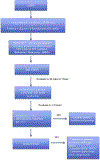Salvage therapies for refractory hypoxemia in ARDS
- PMID: 30053961
- PMCID: PMC6186150
- DOI: 10.1016/j.rmed.2018.06.030
Salvage therapies for refractory hypoxemia in ARDS
Abstract
Acute Respiratory Distress Syndrome (ARDS) is a condition of varied etiology characterized by the acute onset (within 1 week of the inciting event) of hypoxemia, reduced lung compliance, diffuse lung inflammation and bilateral opacities on chest imaging attributable to noncardiogenic (increased permeability) pulmonary edema. Although multi-organ failure is the most common cause of death in ARDS, an estimated 10-15% of the deaths in ARDS are caused due to refractory hypoxemia, i.e.- hypoxemia despite lung protective conventional ventilator modes. In these cases, clinicians may resort to other measures with less robust evidence -referred to as "salvage therapies". These include proning, 48 h of paralysis early in the course of ARDS, various recruitment maneuvers, unconventional ventilator modes, inhaled pulmonary vasodilators, and Extracorporeal membrane oxygenation (ECMO). All the salvage therapies described have been associated with improved oxygenation, but with the exception of proning and 48 h of paralysis early in the course of ARDS, none of them have a proven mortality benefit. Based on the current evidence, no salvage therapy has been shown to be superior to the others and each of them is associated with its own risks and benefits. Hence, the order of application of these therapies varies in different institutions and should be applied following a risk-benefit analysis specific to the patient and local experience. This review explores the rationale, evidence, advantages and risks behind each of these strategies.
Keywords: Acute respiratory distress syndrome; Lung; Refractory hypoxemia; Salvage therapies.
Copyright © 2018 Elsevier Ltd. All rights reserved.
Figures
Similar articles
-
Approaches to refractory hypoxemia in acute respiratory distress syndrome: current understanding, evidence, and debate.Respir Care. 2011 Oct;56(10):1573-82. doi: 10.4187/respcare.01366. Respir Care. 2011. PMID: 22008398
-
Severe hypoxemic respiratory failure: part 2--nonventilatory strategies.Chest. 2010 Jun;137(6):1437-48. doi: 10.1378/chest.09-2416. Chest. 2010. PMID: 20525656 Review.
-
Management of Acute Respiratory Distress Syndrome and Refractory Hypoxemia. A Multicenter Observational Study.Ann Am Thorac Soc. 2017 Dec;14(12):1818-1826. doi: 10.1513/AnnalsATS.201612-1042OC. Ann Am Thorac Soc. 2017. PMID: 28910146
-
Management of refractory hypoxemia in ARDS.Minerva Anestesiol. 2013 Oct;79(10):1173-9. Epub 2013 Jul 15. Minerva Anestesiol. 2013. PMID: 23857446 Review.
-
The Role of Rescue Therapies in the Treatment of Severe ARDS.Respir Care. 2018 Jan;63(1):92-101. doi: 10.4187/respcare.05752. Epub 2017 Oct 24. Respir Care. 2018. PMID: 29066591 Review.
Cited by
-
Physiologic Improvement in Respiratory Acidosis Using Extracorporeal Co2 Removal With Hemolung Respiratory Assist System in the Management of Severe Respiratory Failure From Coronavirus Disease 2019.Crit Care Explor. 2021 Mar 9;3(3):e0372. doi: 10.1097/CCE.0000000000000372. eCollection 2021 Mar. Crit Care Explor. 2021. PMID: 33786448 Free PMC article.
-
Lumican is elevated in the lung in human and experimental acute respiratory distress syndrome and promotes early fibrotic responses to lung injury.J Transl Med. 2022 Sep 4;20(1):392. doi: 10.1186/s12967-022-03597-z. J Transl Med. 2022. PMID: 36059026 Free PMC article.
-
Advanced Pulmonary and Cardiac Support of COVID-19 Patients: Emerging Recommendations From ASAIO-a Living Working Document.Circ Heart Fail. 2020 May;13(5):e007175. doi: 10.1161/CIRCHEARTFAILURE.120.007175. Epub 2020 May 1. Circ Heart Fail. 2020. PMID: 32357074 Free PMC article.
-
Acute Respiratory Distress Syndrome and the Use of Inhaled Pulmonary Vasodilators in the COVID-19 Era: A Narrative Review.Life (Basel). 2022 Nov 2;12(11):1766. doi: 10.3390/life12111766. Life (Basel). 2022. PMID: 36362921 Free PMC article. Review.
-
Acute Kidney Injury in Patients with Severe ARDS Requiring Extracorporeal Membrane Oxygenation: Incidence, Prognostic Impact and Risk Factors.J Clin Med. 2022 Feb 18;11(4):1079. doi: 10.3390/jcm11041079. J Clin Med. 2022. PMID: 35207357 Free PMC article.
References
-
- Ranieri VM, Rubenfeld GD, Thompson BT, Ferguson ND, Caldwell E, Fan E, et al., Acute respiratory distress syndrome: the Berlin Definition, J. Am. Med. Assoc 307 (23) (2012) 2526–33. - PubMed
-
- Bellani G, Laffey JG, Pham T, Fan E, Brochard L, Esteban A, et al., Epidemiology, patterns of care, and mortality for patients with acute respiratory distress syndrome in intensive care units in 50 countries, J. Am. Med. Assoc 315 (8) (2016) 788–800. - PubMed
-
- Cannon JW, Gutsche JT, Brodie D, Optimal strategies for severe acute respiratory distress syndrome, Crit. Care Clin 33 (2) (2017) 259–75. - PubMed
-
- Pipeling MR, Fan E, Therapies for refractory hypoxemia in acute respiratory distress syndrome, J. Am. Med. Assoc 304 (22) (2010) 2521–7. - PubMed
-
- Wiedemann HP, Wheeler AP, Bernard GR, Thompson BT, Hayden D, deBoisblanc B, et al., Comparison of two fluid-management strategies in acute lung injury, N. Engl. J. Med 354 (24) (2006) 2564–75. - PubMed
Publication types
MeSH terms
Substances
Grants and funding
LinkOut - more resources
Full Text Sources
Other Literature Sources


